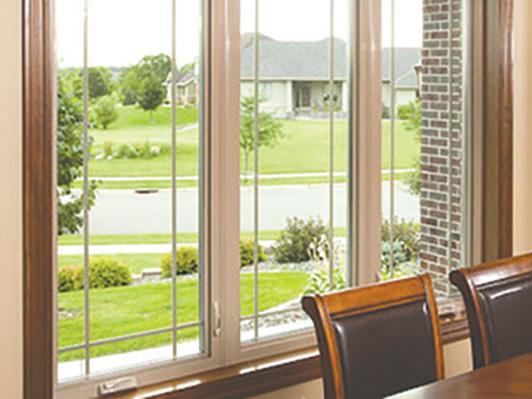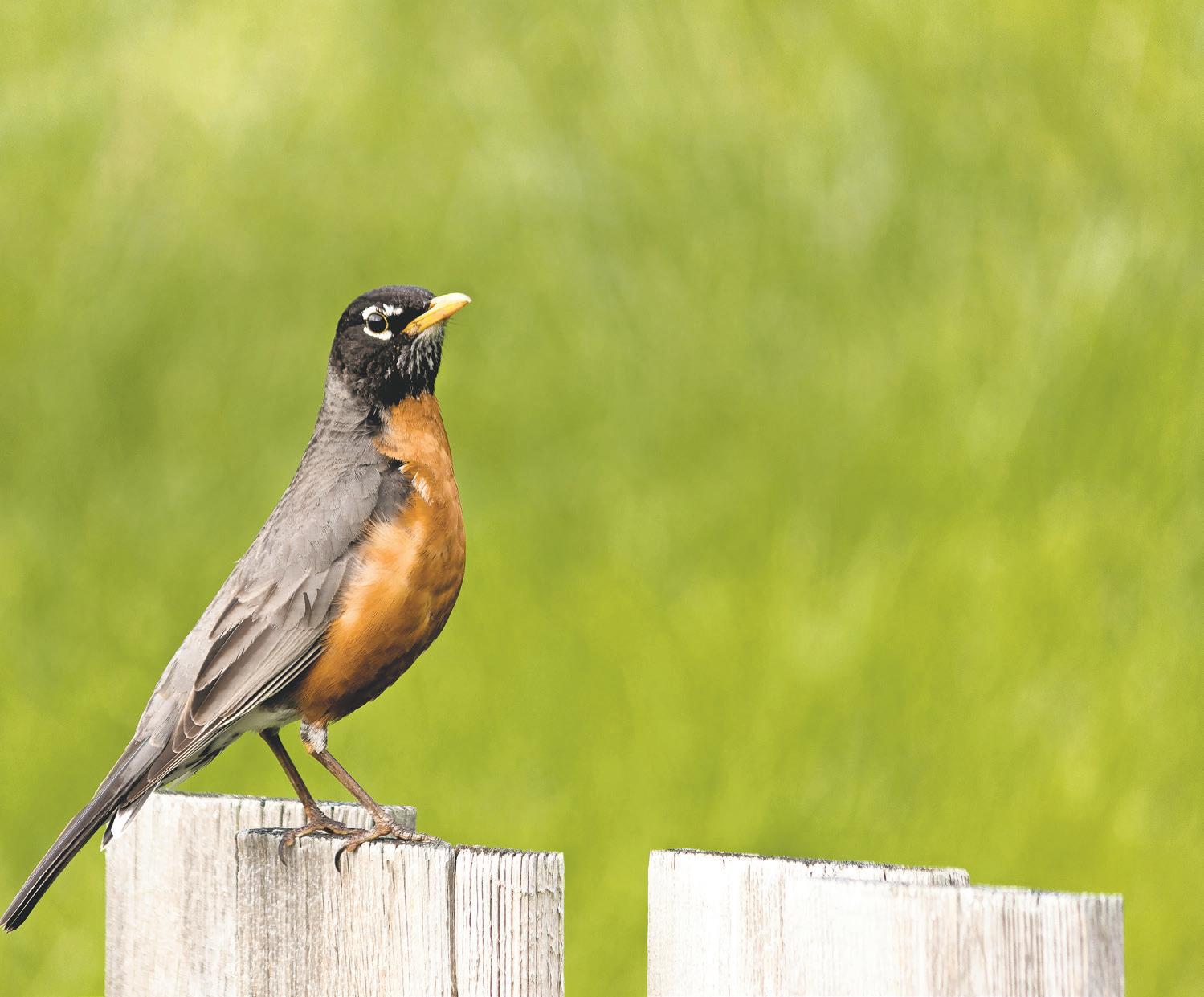








WILLMAR — Research from 2005, using data from NASA satellites, showed that the largest irrigated crop in the United States wasn’t corn, or soybeans or wheat. No, the largest irrigated crop, covering over 50,000 square miles, three times more than corn, was residential turf lawns.
While a bright green, perfectly manicured, weed-free lawn might be the height of landscaping success for many, for pollinators such as bees and butterflies it might as well be the Sahara.
“A manicured lawn is a biodiversity desert,” said Aaron Wilson, the farm biologist for Pheasants Forever working in the office of the Kandiyohi County Soil and Water Conservation District.
Over the last few years, Wilson has been one of a growing number of people transforming their turf yards into pollinator havens. As someone who works to create habitat for wildlife, it only make sense that he would want to do the same at his home.
“Pollinators are becoming a more key target species we are looking to assist,” Wilson said. “I have space in my yard that I don’t use for anything else, don’t like mowing it or caring for it in other ways. It is a pretty easy solution to have something that looks nice and provides for those native species.”
There are various landscaping options those with a bit of yard can do to help pollinators. They can plant native flowers, creating a pocket prairie or rain garden, or even transform that turf yard into a flowering bee lawn.
“The benefits are stacked upon themselves,” said Ryan Peterson, district technical coordinator for the Kandiyohi County SWDC.

When designing your yard, consider a landscape created for both humans and pollinatorsA bee digs into a flower at Aaron Wilson’s pollinator planting in Kandiyohi. Gardeners should plant flowers that provide high-quality nectar and pollen for pollinators. Contributed / Aaron Wilson
When deciding what flowers to plant in landscape beds and gardens, choosing native species can be a great help to native pollinators. Some pollinators can be very specific about what plants they will eat or lay eggs on, such as with the monarch butterfly and milkweed.
It is also important to choose flowers that make it easy for pollinators to get to the nectar and pollen. Plants that provide high quality and quantity of food is yet another necessity for pollinator health, and many natives do that. Good choices include native bloodroot (sanguinaria canadensis), corcus (crocus versus) and purple prairie clover (Dalea purpurea).
“They provide the best food quality, pollen, nectar. They are also the most adaptable to our incredibly variable weather we have, thanks to climate change,” said Julie Weissen, University of Minnesota Extension horticulture educator, during a Jan. 31 University of Minnesota Extension webinar on creating pollinator-friendly landscapes.
Flowering trees and shrubs can be great options for those wanting to help pollinators but don’t want to make massive changes to their landscapes. Trees such as basswood or linden are a very important source of nectar for honey bees in this region.

“Any sort of fruit-bearing shrub or tree,” can be a good choice, Peterson said. Another thing to watch for is good habitat. Many bee species winter underground, so keeping leaf litter around over winter or deciding not to clean out the garden until spring is a way to provide that needed space. Plants with porous woody stems are great homes for bees.
“Less tidy is better for bees,” Wiessen said. “Don’t be so tidy.”
It might require a bit of research to find the right plants for a planting, as not every garden center or nursery sells either the plants or seeds. It is also important to avoid plants or seeds treated by chemicals, as some may be toxic to pollinators.
“Talk to your nursery, shop local, start from seed, collect seed,” Weissen said.
The University of Minnesota Extension, Department of Natural Resources and the Xerxes Society can be good resources to find native plant suppliers. In western Minnesota, there is Morning Sky Greenery in Morris.
“You can pretty much find native plants for any particular site as long as you can grow plants there,” said Sam Talbot, University of Minnesota Extension educator from Dakota County, during a Feb. 2 University of Minnesota Extension webinar on pocket prairies.

There are different ways people can use their landscape to help pollinators. Projects such as pocket prairies or bee lawns might take a bit more work to create and establish, but they can bring big benefits for pollinators.

Pocket prairies are native prairie restoration projects that are less than an acre and are great for residential yards. While the original native prairies were usually 80% grasses, many residential projects can have more flowers. Rain gardens, which are plantings in low areas to collect rainwater off roofs, driveways and yards, are another great place to put flowers and plants that are good for pollinators. That way you can get the benefits of a pollinator planting and reduce water runoff.
“The nice thing about prairies and establishing pollinator habitat is that you can sort of approach it at really any scale and any level of expertise, that includes your backyard,” Talbot said. “We want to do everything we can to provide a diverse selection of pollen and nectar sources.”
Wilson has seen pollinators of all sorts flock to the plantings he has done, both at his own home and his parent’s place in Brooklyn Park.
“All kinds of insects, bees, butterflies and moths,”
along with beetles and grasshoppers, were seen crawling around those plantings, Wilson said Pocket prairies and rain gardens also still leave room for a turf lawn if that is important to the residents, or needed to meet city regulations.
“When you put that bullet edging around there, they are kind of confined and still have a manicured look,” Peterson said.
For those who want a lawn, but also feel its important to assist pollinators, probably the most transformational project someone can do is a bee lawn. Instead of a yard of just Kentucky bluegrass or another turf species, a bee lawn is usually a fine fiscus grass and several low growing flowering plants such as self-heal, creeping thyme and Dutch white clover.
There are many benefits to a bee lawn, for both the bee and the human. Not only do the lawns provide food for bees throughout the growing season, but bee lawns, one established, usually require less mowing, fertilizer and water to be successful.
“We want to provide habitat and food for our pollinators within a landscape of turf grass where humans desire play, they desire gathering, they want to have a picnic, play with the dog,” said James Wolfin, of Twin City Seed Company, during a Feb. 1 University of Minnesota Extension webinar on bee lawns.


Wilson is planning this spring, once the snow finally melts, to take his own turf backyard and turn it into a bee lawn. If all goes well, he might turn his front yard into a bee lawn as well. While he plans to do most of the work himself, he isn’t doing it all alone, there is help available. Last fall, Wilson applied for and received a $350 grant from the Lawns to Legumes program to help fund his bee lawn project.
Lawns to Legumes was started in 2019 as a way to help restore habitat for the threatened Rusty Patch bumblebee, the official state bee. The Minnesota Board of Soil and Water Conservation, along with partners Blue Thumb and Metro Blooms, offers grants to residents wanting to do pollinator habitat plantings in their residential yards.

The program also provides project coaching. Peterson is one such coach, available to help grantees through their projects. He assists with site and plant selection, probably the most important decisions to be made in a project.
“Helping make sure their projects are successful,” Peterson said.


Local SWCD offices are great resources for those interested in a pollinator project. They can give help with projects large and small. The Kandiyohi County office has created its own pollinator seed mix people can purchase, sells rain barrels and can assist people in designing their rain gardens, pocket prairies and other projects.
The interest in pollinator plantings has gone up in the last few years. Peterson said only a decade ago it was nearly unheard of, but now more and more people are starting to think of the bees and butterflies when landscaping or maintaining their yards.
“It is a lot easier than people think it could be,” Wilson said.
The hope is the interest continues to grow and the perception that a manicured turf lawn changes to allow for more alternative residential landscapes. The more yards that provide food and habitat for pollinators the better.
“Start somewhere. Start with a couple of plants even,” Peterson said.

While the ubiquitous dandelion can provide some food for pollinators, for the most part turf lawns are food deserts for Minnesota bees, butterflies and other pollinators.
“It is a lot easier than people think it could be.”
- Aaron Wilson
“Start somewhere. Start with a couple of plants even.” - Ryan Peterson





It may feel like warm weather is still a way’s off, but you should already be getting your lawn and garden springready, according to experts.
“One thing I don’t think people realize is that to get your grass, shrubs and other plants looking good in the spring…all that preparation starts right now,” said Major League Fishing bass pro Brian Latimer, or “Blat” as he is known by fans.
To help homeowners prep for spring, Latimer has partnered with lawn care equipment manufacturer, Exmark, to offer his four go-to tips:

According to Latimer, the most important step in prepping your lawn and garden for spring is weeding.

“I have a zero-tolerance policy when it comes to weeds,” he said. “Watch those sneaky weeds growing in your shrubs and ground covers, because those are going to be the first ones that show their heads in the spring.”
While weeding isn’t the most fun you can have in your yard, it’s worth the effort. Latimer also recommends putting a pre-emergent out now while cool-season weeds germinate. This is especially important if you have warmseason grass. While you can use preemergent on your planting beds as well, he recommends hand-pulling them if you can.



Pruning will make your shrubs look nice and tidy, however Latimer recommends being careful in your efforts, avoiding plants that are

budding. Pruning buds will keep your flowers from being as prolific in the springtime. You can check for buds by combing your hands through the foliage.

Certain spring pests should be treated for in the colder months. Latimer is especially wary of fire ants, as they’re one of the most active lawn pests in spring. Treating them early will minimize their activity and mitigate potential problems they cause when the weather warms up.
“I can promise you they are going to be everywhere in warm weather, so treat them now,” he said.
Latimer knows that leaf blowing or raking is time-consuming, but he says that getting fallen leaves off the ground is essential. Not only are leaves on your lawn an eyesore, but they can also keep a lot of excess moisture from winter rain, snow and ice stuck in your soil. This creates the potential for root rot, active pests and germinating weeds.
Latimer offers more insights in “4 Tips to Prep Your Backyard for Spring,” a recent video from Exmark. To watch the video, visit Backyard Life, which is part of a unique multimedia destination with a focus on helping homeowners make the most of outdoor spaces. There you can also download additional tips and view other Exmark videos.
There’s no time like the present to plan for the future. With these great tips in mind, it’s time to brave the brisk weather and get your lawn and garden prepped for spring.


This spring home improvement season, get inspired by the outdoors with biophilic design.
“Biophilic design – the concept of integrating nature into interior design – is not only gorgeous, it fosters a healthy living environment, promotes happiness and comfort, and reduces stress,” said Jennifer Kline, multimedia graphic artist at ProVia. “There are many ways to reap these wellness benefits while adding vitality to your living spaces.”

To connect to the natural world within your home, consider these ideas:


Taking a stroll through the forest can summon feelings of tranquility. Capture this inner peace at home from the moment you step inside with a fiberglass woodgrain entry door.
Those from ProVia provide authentic-looking woodgrain textures, such as oak, cherry, mahogany, knotty alder and fir, and can accommodate various door glass enhancements. Engineered for energy efficiency, they’re also a sustainable choice, helping you protect the natural world as you embrace its splendor.

Other design choices, such as exposed rustic ceiling timbers, rich hardwood furniture, warm hardwood floors and vinyl woodgrain windows can help you carry the forest motif
throughout the home, while imbuing interiors with richness and warmth.

“If you’re lacking natural light, it’s time to open those blinds and drapes and let the sunlight stream through your windows. It may also be time to consider a few enhancements that will help you enjoy more sunshine and observe your natural surroundings, even when you can’t be outdoors,” Kline said.
For kitchens and breakfast nooks, bathrooms and dens, consider vinyl garden windows, which invite more light into your space and include shelves ideal for housing indoor plants, such as fragrant herbs. Their three-dimensional design helps give rooms an airy, spacious feel. Family rooms and bedrooms are great locations for vinyl picture windows, which let in large amounts of light while providing unobstructed views of outdoor scenery. Need inspiration? Visit ProVia’s Window Photo Gallery at www. provia.com/windows.
To brighten your foyer, add an entry door with glass. Energy efficient sliding glass patio doors also let in sunlight, and give you the option to invite fresh air into your home or enjoy the melodies of singing birds on nice days. Skylights can flood small or closed-off spaces such as walk-in closets or bathrooms with light and give you views of blue skies.

for integrating nature into your interior design







To give your home a welcoming, fresh feel, add various houseplants and indulge in fresh-cut flowers. A windowsill with small plants of varying shades of green can add texture, while larger potted plants near doorways help guests feel welcome. Fill dark, underutilized spaces with taller plants and place bright, lightly-scented garden flowers in such spots as the kitchen island and coffee tables. Use earthen or woodcarved vases for additional warmth.















From the warm brown tones of a picturesque southwestern mesa to the cool, earthy feel of quarried rock, manufactured stone veneer adds rugged texture, intriguing patterns and shapes, and a variety of hues straight from Earth’s natural color palette. Whether you’re creating a focal point in a bedroom with an accent wall, adding character to your kitchen with a stone veneer backsplash, surrounding a tub with stone veneer for a spa-like bathroom, or highlighting your fireplace, different stone profiles and grout colors can help you customize the look. Experiment with combinations using ProVia’s visualizer tool found at provia.com/stone/grout-visualizer. “Incorporating biophilic elements into your interior design can transform your home into a warm respite from your busy life,” Kline said.



“INCORPORATING BIOPHILIC ELEMENTS INTO YOUR INTERIOR DESIGN CAN TRANSFORM YOUR HOME INTO A WARM RESPITE FROM YOUR BUSY LIFE”
- Jennifer Kline
Plants add color, life and vibrancy to your home’s indoor and outdoor spaces and can even improve indoor air quality. However, if you are new to plant ownership, you may be wondering how to make your foliage thrive. Here’s are three tips for healthier plants: MAKE A MOVE. Many plants that do well outdoors in the warmer months can’t tolerate the cold. So don’t wait for subfreezing temperatures to bring planters indoors for the season. Be sure to give your newly-transported plants the right amount of light. This may require using special grow lights. Keep in mind though that different types of plants thrive better with different color spectrums and intensities, so group plants under the right lights accordingly. If your indoor air is dry in winter, you may find that misting the leaves of your warm climate and tropical plants will help provide needed humidity.


PREVENT PESTS. Unfortunately, keeping houseplants often attracts insects that can harm them and bug you. But there are steps you can take to prevent a pest problem in your home. One important thing you can do is to be sure you are not overwatering plants. Too much water in effect drowns plants. It


can also create standing water that becomes a breeding ground for flying insects. You can also provide round-the-clock protection from fruit flies, gnats and flies by plugging a Zevo Flying Insect Trap into a regular outlet near your plants and wherever flying insects enter your home or gather. Rather than chemical insecticides, the traps use multi-spectrum light technology to attract flying bugs into a discreet glue sheet cartridge. When the cartridge is full, replace it and toss the used one without ever having to touch a dead bug. To learn more, visit zevoinsect.com.
KNOW YOUR LIFESTYLE AND LIMITATIONS. There are many plant species that while beautiful, don’t require much care. So, if you’re new to owning plants, consider starting out with lower-maintenance options, such as succulents or snake plants. Because these plants don’t need much water, they are also great options for those who travel frequently or those who are simply forgetful. Have furry friends? Always check whether a given plant is toxic to pets before bringing one home.
Having a green thumb can seem like magic. However, with the right tools and knowledge, anyone can become a nurturing plant parent.





Many people take to the great outdoors to escape the increasingly tech-driven daily grind. Though that’s an understandable perspective, gardeners who aren’t deploying tech in their home gardens could be missing out on a host of benefits that could help their plants, flowers and vegetables thrive.
Devices like smartphones and tablets have made many aspects of life easier and more efficient, and various tech products can do the same when working in the garden.



PLANT MONITOR: Plant monitors are sensors that can keep tabs on the health of plants and deliver that information to gardeners. Plant monitors often connect to smartphones via Bluetooth and can deliver information on the amount of heat, light and water a plant is getting. Sensors vary in price, and some will provide more information than others. But these sensors are ideal for gardeners who
love their plants but often forget to check up on them each day.
GARDEN CAMERA: Critters and insects are the bane of many gardeners’ existence. Determining just what is nibbling away at flowers and plants isn’t always so easy, as many animals are savvy enough to restrict their dining to the middle of the night and insects are so small they can be hard to spot. Garden cameras can serve as the watchmen of a garden and gardeners can review footage to determine just who is compromising all of their hard work. They can then use that knowledge to remedy the situation and give their plants a better chance to thrive.
WEATHER STATION: Even the most seasoned gardeners cannot document the conditions outside as effectively as a good weather sensor. Weather sensors track conditions such as temperature, relative humidity and air quality. This information


can then be paired with irrigation devices to ensure plants get all the care they need to thrive throughout the season.

GARDEN HUB: Avid gardeners have traditionally had to arrange for neighbors or loved ones to tend to their plants when they leave home for vacation or weekend getaways. Garden hubs can take care of that by pairing with smart irrigation systems that ensure plants are watered even when no one is home. Certain hubs even gather and analyze local weather conditions to develop a watering schedule to ensure plants thrive. These hubs aren’t just handy when on vacation, as they can be great for gardeners who want to know things about their plants that are not apparent to the naked eye. People may see their gardens as welcome respites from their devices. But garden gadgets can help plants thrive and make time in the garden that much more enjoyable.

It can be tempting to think that bugs simply disappear in the cooler months. The truth is that many bug species have evolved to survive all year long, sometimes hiding in the warm nooks and crannies in and around homes. Others go into a hibernation-like state.
“Bugs can be a lot smarter and more resilient than you may realize. Even if you don’t see household pests right now, some may still be waiting in your home for those first warm days to signal them to become active, search for food and find a mate,” said Emma Klingman, senior products research at Zevo, a maker of pest control products with naturally-inspired ingredients you can feel good about.
To prep your home for bug season and outsmart pests, follow these three steps:

TIDY UP. Household pests love snacking just as much as people do, but you don’t need to play host to them. After meals, wipe down tables, counters and other kitchen surfaces. Be sure to regularly sweep and vacuum crumbs, as well as mop up to eliminate sticky food residue. Keep a tightly-fitting lid on your garbage bin, and rinse cans and jars before recycling them.
BE READY. Even an immaculate home will face pest problems at some point. That’s why it is important

to have tools on hand to catch a problem early, before it becomes a much bigger one. Zevo’s Instant Action sprays target and shut down biological pathways found in insects, not in people or pets. Likewise, the brand’s
traps use a UV and blue light system to attract and capture flying insects, and they have a discreet design that can serve as a bouncer at your home’s entry points. It’s also smart to use these traps in potential problem areas, such as near
trash cans and fruit bowls and near toilet bowls and drains.
SAFEGUARD THE YARD.
Defending your yard from pesky pests will not only improve the comfort of your home’s outdoor spaces, it will
help prevent insects from finding their way indoors. Be sure to eliminate standing water by properly tending to your lawn and by periodically clearing downspouts of debris. Any water feature in your garden should use running water. If you have a patio or deck, consider screening it in. If you don’t love the look of screened walls, installing ceiling fans can be an effective alternative. Run the fans whenever you entertain to deter unwanted guests, such as mosquitos, from crashing the party.
Of course, it’s always a good idea to apply bug repellant when spending time outdoors. Find a formula that will be easy to use, such as the new on-body products from Zevo, which include a pump spray, aerosol and lotion. They offer eight hours of protection from mosquitoes and ticks and are lightweight, odorless and not sticky.
For more usage tips and more information, visit zevoinsect.com and follow on Facebook, TikTok and Instagram (@ZevoInsect).
“As we usher in gorgeous spring weather, it can be an especially challenging time of year to keep bugs at bay at home. But with the right tools and strategies, you can help prevent and combat infestations as they arise,” Klingman said.


Gardening is a rewarding hobby that has been linked to health benefits like reduced stress and improved mental well-being. Gardening also can lead to an inviting home landscape full of attractive blooms and/or delicious foods.





Backyard gardens have long been planted after clearing a plot of land, tilling and amending the soil, and planting rows of favorite crops. However, gardening can be less labor-intensive and even more successful when people consider the many benefits of container gardening. What is container gardening?

As its name implies, container gardening is growing plants inside of containers. These containers can be flower pots, rectangular deck boxes or even large raised garden beds.
PROS TO CONTAINER GARDENING. One of the advantages of container gardening is that plants can be moved in and out of sunlight to ensure the right growing conditions. This isn’t as easily achieved when gardens are stationary. Also, beginner gardeners may be more able to control soil conditions inside of a small container rather than a vast ground-based garden, which will require a good deal of manual labor. Pots and boxes also can be grouped together to create eyepopping displays, usually at lower costs than the sheer volume of plants that would be needed to fill out an expansive landscape.
CONS TO CONTAINER GARDENING. Container garden plants will not have direct access to the ground, so they need gardeners to create the ideal growing conditions. Developing
the right care formula can be challenging. The home and garden resource The Spruce says that drainage is an important factor in container gardening, and most containers do not offer enough drainage holes. If water cannot escape the soil, the roots of the plants can rot and die. It’s not enough to add stones or gravel to the bottom of containers. Drill additional holes in the bottom (1 to 2 inches in diameter for small or medium-sized pots; one inch in diameter for larger pots). Also, be sure to check on soil moisture so that watering can be adjusted. During hot stretches, plants may need to be watered more frequently.

PLAN FOR PLANTS THAT PLAY WELL. Grouping plants together can create visually stunning combinations. However, it is important to choose plants that require the same amount of light and moisture. Look at plant tags when visiting the garden center and select complementary plants, or ask a store employee. Mixing different plant shapes, colors and leaf textures, as well as plants of various heights, can help containers look filled out.
FEED PLANTS ACCORDINGLY. Plants need nutrition to thrive in containers. Quality potting mixes will contain fertilizers, but nutrition will wane over time. Every couple of weeks, container plants will need either fresh potting mix or granular fertilizer added to feed them. Oregon State University Extension Services suggests using a slow-release fertilizer or worm castings several times throughout the season.
Container gardening is a great way to add plants to smaller patios, reduce the workload involved in maintaining expansive gardens, and customize conditions for optimal growth.
New plants can add much to a landscape. Whether they’re replacing plants that are no longer thriving or being added to supplement an existing landscape, new plants are an affordable way to give a home’s exterior a whole new look.
Much consideration is given to which plants to add to a landscape. That’s understandable, as homeowners want to choose plants that will thrive and won’t compromise the health of surrounding plants and trees. Before planting or even choosing plants, it’s important to plan for new additions to a landscape. Preparing the landscape can inform homeowners about which plants to purchase and can ensure they thrive after planting.
DOCUMENT SUNLIGHT EXPOSURE. Plants have different needs, and one of the biggest differences between species is the amount of sunlight they need to thrive. According to Penn State Extension, plants characterized as “full sun” require six or more hours of sunlight per day, while those considered “partial sun” need between four and six hours of sunlight per day. Plants designated as “partial shade” need two to four hours of sun per day, while “shade” plants need less than two hours of sunlight a day. Documenting sunlight exposure in advance gives homeowners an idea of which plants should be planted and where they should be planted. Jot down these observations in a journal over several weeks and then choose plants that will thrive in each area.
TEST THE SOIL. A soil pH test is a simple and quick way to determine

the acidity of soil. Soil pH levels will indicate how likely a plant is to thrive in a given spot. High levels won’t necessarily mean an area should be avoided, as some plants thrive in acidic soils. Additional soil tests can determine other characteristics, such as the nutrient levels of soil and the amount of organic matter it contains. Each of these variables can help homeowners make the right choices as they introduce new plants to their properties.
CONSIDER LOCAL WILDLIFE. If local wildlife makes its presence known on a property, homeowners may want to take proactive steps prior to planting anything new. A new fence might prevent animals like deer from getting in, but that likely won’t do much to repel smaller animals like squirrels, rabbits or foxes. If wildlife is a concern, homeowners can seek advice at their local garden center about which plants certain animals are likely to ignore. Homeowners who want to attract wildlife can do the same in reverse, choosing plants wildlife will be drawn to. Homeowners who want to deter wildlife should erect fencing or other barriers prior to planting.
Plants grow up and out, and cramped quarters can make it hard for new plants to thrive. Some may thrive but only at the expense of other plants. If necessary, clear space prior to planting to ensure plants have ample space to grow.
Some pre-planting landscape preparation can ensure new plants thrive.







damage

Are you ready for spring?
It seemed like it would never get here and as of this writing, it hasn’t gotten here yet. Makes me think of something I just read: “The only thing I’m growing this spring is older and more irritable!”

With all the snow and ice pack this winter, it has made pruning trees very difficult. There are some evergreen shrubs that have been weighed down by ice and snow since November. What are they going to look like now? Be very careful, it might be too late now to do some pruning.
Pruning in late winter before spring growth starts will minimize the length of time fresh wounds are exposed before the tree starts active growth and can seal the wound.

If you want to avoid Oak wilt (a fungal disease), you need to prune from November through March. Do not prune oaks at all from April through October.
Prune apples, flowering crabapple, mountain ash, hawthorn, serviceberry and cotoneaster trees between February through April to
reduce the spread of fire blight.



Some trees will “bleed” sap if pruned in later winter. This doesn’t hurt the tree, but it makes you feel bad when you see it. Wait to prune maple, butternut, black walnut, ironwood and beech in late spring or early summer after leaves have fully expanded. You may have noticed that birch trees bleed sap when pruned in late winter but the University of Minnesota says this timing is preferable because it helps avoid attracting bronze birch borers, which are active during the growing season. This varmint girdles susceptible birch trees, blocking the vessels that move water and nutrients through the trees.
Shrubs grown for foliage or bloom in summer should be pruned in late winter or early spring before new growth starts. Deadhead a third of older branches to encourage new growth. Remove winter dieback. Spring blooming shrubs (i.e., lilac) should be pruned immediately after spring bloom in order to prevent cutting off buds for next year’s bloom.
DAMAGE: Page 14
As winter turns to spring, check your trees and shrubs forContributed / Sue Morris Tulips are one of several plants that are situated to grow in Minnesota and survive the winters to bloom again come spring. Master gardener Sue Morris cautions to avoid pruning, fertilizing and overwatering in late summer to prevent winter dieback.
Not only are there be problems with the early ice and heavy snow that affected our shrubs this winter, there are two other things that affect them — sunscald and winter dieback.
Sunscald is when there are dried or cracked areas of dead bark usually on the south side of a tree with thin bark.
This happens when winter sun heats up tree bark and stimulates cell activity and then when a cloud or building blocks the sun, the bark temperature drops rapidly and the active cells in the plant are killed and the bark cracks forming a frost crack. This usually occurs in young and/or newly planted trees. Older trees have thicker bark that insulates and keeps tissue dormant and cold hardy.
The best way to prevent this from happening is to wrap the trunks of young and thin-barked trees with white guards or wrap for the winter and remember to remove the guards in the spring after last frost. Don’t use dark tree wrap, as that will absorb heat from the sun and defeat the purpose.
Winter dieback is another problem but there isn’t much that can be done to protect trees and shrubs from that.
Choose hardy plants for our zone 4 and those that will match your site conditions. Our winter temperatures and conditions vary in Minnesota. Because of this, there is not much that can be done to protect trees and shrubs from dieback. However, you can take management steps to reducing dieback. Choose hardy plants with growing requirements that match your site conditions. Avoid pruning, fertilizing and overwatering in late summer. (Don’t use fertilizer after Aug. 1.)
Remember we have had drought the last couple of years. It has been said that drought stressed trees can take up to five years to be affected and by that time we have forgotten about the drought and wonder what is affecting these trees.
Nothing says spring like freshly-baked rhubarb muffins.

Hopefully, by now, rhubarb is soon ready to harvest. (This column was written the first week of April while my rhubarb was still under two feet of snow.)
Rhubarb can’t be grown in southern states, as it needs our cold and dormant winters to survive. After this winter, the rhubarb should be thriving. Here is my favorite recipe:
► ¾ cup brown sugar

► ½ cup oil
► 1 egg beaten
► ½ cup buttermilk
► ½ tsp salt

► 1 tsp vanilla

► 1 ½ cup sifted flour plus 1-2 tbsp

► ½ tsp soda
► ½ cup nuts
► 1 cup rhubarb chopped fine
Mix as given. Recipe should fill 12-14 muffin cups.
► ¼ cup brown sugar
► 1 tsp cinnamon
► ½ cup nuts chopped
Dust topping over muffin cups. Bake at 350 degrees for 15 to 20 minutes.
Master Gardener Sue Morris has been writing this column since 1991 for Kandiyohi County newspapers. Morris has been certified through the University of Minnesota as a gardening and horticulture expert since 1983. She lives in Kandiyohi County. To consult with a Master Gardener, call your county Extension office.

METRO CREATIVE CONNECTION
Homeowners frequently enhance their outdoor living spaces with attractive plants and trees. When that greenery also produces food, the results can be both beauty and bounty.
People who plant vegetable gardens and fruit trees in their yards can be blessed with an abundance of fresh pickings once it’s time to harvest. In fact, many home gardeners may have visions of warm evenings pulling vegetables right out of the garden and tossing them on the grill or in salads. But insects and animals enjoy fresh produce just as people do. The joy of harvesting from a garden can be diminished when unwanted guests have gotten there first.
Homeowners can employ these all-natural strategies to protect their fruits and vegetables from lawn pests and critters.
PLANT GARDENS IN RAISED BEDS. Though they’re not a fool-proof deterrent, raised beds can
Over 100,000 square feet of highly decorated showroom space



women’s boutique.
eliminate some garden infiltration by small critters that come up and under from the ground. A raised garden bed can deter rabbits, gophers, groundhogs, slugs, and some other crawling pests. Raised beds also are ergonomic and easily accessible.
PREPARE HOMEMADE INSECTICIDE. The environmental information site Treehugger provides information on making a homemade insecticide from vegetable oil and a mild soap. Use one cup of oil with one tablespoon of soap (such as Dr Bronner’s castile soap). Add this mixture to one quart of water in a spray bottle. This concoction can eradicate aphids, mites, thrips, and more by coating insects’ bodies and effectively suffocating them. Soap-and-water sprays or even neem oil sprays work similarly.
SPRINKLE DIATOMACEOUS EARTH. Diatomaceous earth, commonly known as DE, is an abrasive powder composed of fossilized algae diatoms. It’s commonly used as a filter medium in swimming pools, but also makes an effective pesticide. The material’s abrasive and absorbent

qualities draw moisture out of insects, essentially dehydrating them to death. DE can be sprinkled around the base of plants, but will need to be reapplied after rain and watering.
SPACE OUT PLANTS. One way to reduce insect or animal pest numbers is to ensure ample space between plants. Tightly planted crops create a breeding ground for fungal diseases and also provide hiding spots and warmth for pests. Leaving room between plants can help avoid these issues, according to Gardening Channel.

USE ROW COVERS OR GARDEN MESH. Specialized covers and meshes protect fruit and vegetables against insects and animals. Many plants can be covered all year long as long as the covers are lifted during flowering if the crops depend on pollination by bees. Veggiemesh is a cover that can be laid over plants.
INTERPLANT CROPS IN THE GARDEN. Interplanting is a technique that involves alternating crops, herbs and flowers to confuse the pests so they have a difficult time finding what they want to eat. Alternate rows of vegetables with herbs and flowers that appeal to beneficial insects. Keeping pesky insects and animals from damaging food gardens can involve techniques that are safe and natural.


